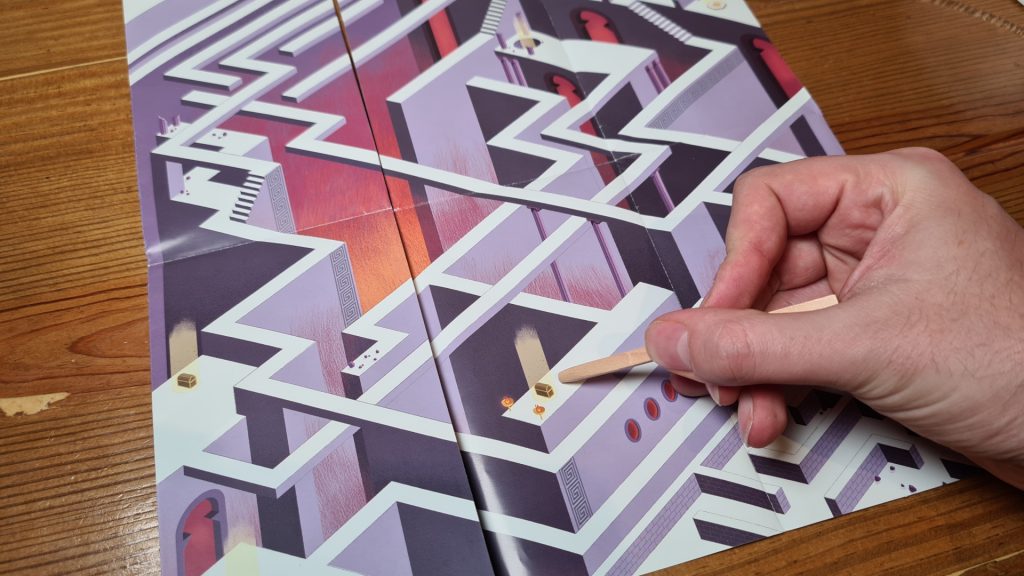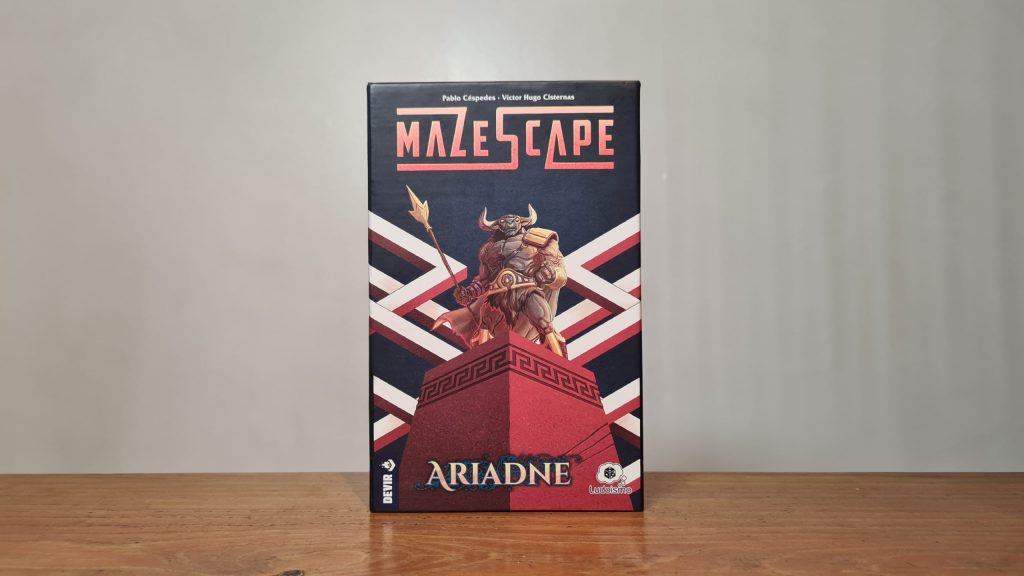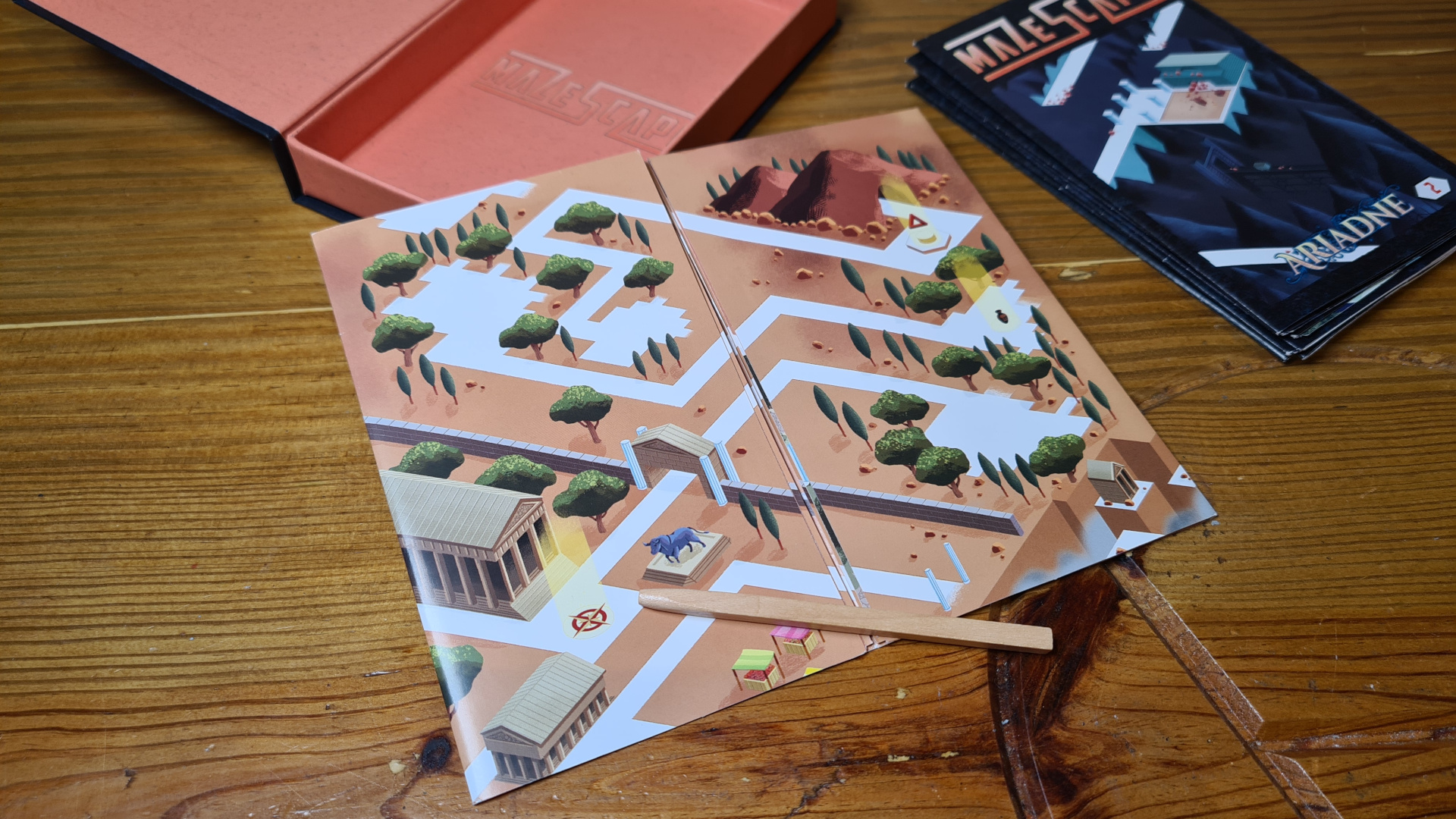Mazescape Ariadne is one of two solitaire maze style games from publisher Devir. Alongside its sister game Labyrinthos, Mazescape Ariadne was designed by Pablo Céspedes and Víctor Hugo Cisternas to be a labyrinth style puzzle for solo gamers. Lasting around 5 – 10 minutes each, both versions feature multiple (and importantly different) mazes to work through. However, is this an experience to get lost in? Let’s find out!
The rules of Mazescape are incredibly simple. The player is aiming to trace a path from the starting compass rose to the impossible triangle end point. Along that path the pen must not be lifted from the page, through the pages of the fold out map can be unfolded. This opens up and closes different paths, with the player eventually making their way to the end point.
The puzzles ramp up in difficulty in multiple ways. Not only do more wiggling routes appear to get lost down on later maps, additional map features and different cuts and folds of map are used. Portals are introduced that break the rule of never lifting the pointer from the page – transporting the player between two concurrently visible portals. Keys and doors also come into play with sections of the mazes closed off until the player has gone past the associated key.

Combining these features with additional cuts, to offer more ways to fold the mazes, means the puzzles stay fresh and keep players coming back for more. There is a sense of the puzzle clicking, when completing multiple mazes in a row, and these new features just help to disrupt this. A disruption can often be considered a negative but in this case the extra elements truly add to the puzzle of the mazes.
Initially, there was a concern that once a maze was played it would be hard to go back to, to get more enjoyment out of the same content. Unlike EXIT or Unlock games, which are single playthrough games, Mazescape has that extra something to allow players to replay the mazes. Each of the 7 included maps features multiple secondary objectives. These are additional items, such as chests, to find along the way. While players will go past some of these on their natural progression from the compass rose to the impossible triangle, most are found off the normal path.
The supposide story behind the mazes is that a minotaur is holding Ariadne, in his deepest dungeon. Of course it’s a hard ask for puzzles of any kind to convey this message. Before the final maze, none of the items collected for the secondary objectives, nor the logic of linking the compass rose to the impossible triangle, seem to really link to this theme though. Replacing them with perhaps clues left behind at each stage by Ariadne would have somehow brought the lore more to life.

Production wise the maps feature stunning artwork by Joan Guardiet and Álex Santaló, with Ivana Gahona producing the art for the Labyrinthos mazes. These weird and wonderful locations have some great little touches and details to them, with the paths all clear and obvious – though not which path is the correct one. Over time the constant folding of the maps may start to show some wear and tear. This could be especially a problem for the puzzles with multiple cuts along folds. This won’t be an issue for many plays, though is still something to consider if wanting to pass it onto many friends and family members.
Mazescape is a very simple fold out map experience. Unfolding one and starting to trace a route is a relaxing experience for the first few maps and a bit of a brain noodling one by the seventh maze. Upon completing a map it’s hard not to want to swiftly move onto the next, and you can happily sit there and work your way through them – though from start to finish will take well over an hour. It’s not quite a one and done situation either, with the extra objectives often tricky to pick up unless actively trying to. Mazescape might not be endlessly replayable but there is a lot of chilled fun to be had working through the labyrinths.
(Editor’s Note: Mazescape Ariadne was provided to us for review by the publisher. More details can be found on the on the Thames and Kosmos store.)

